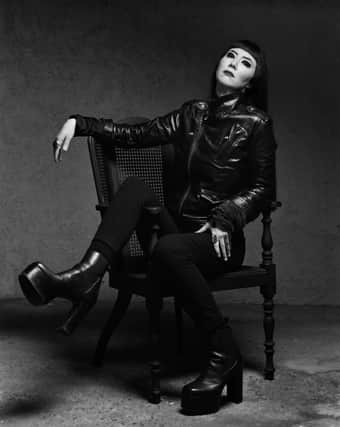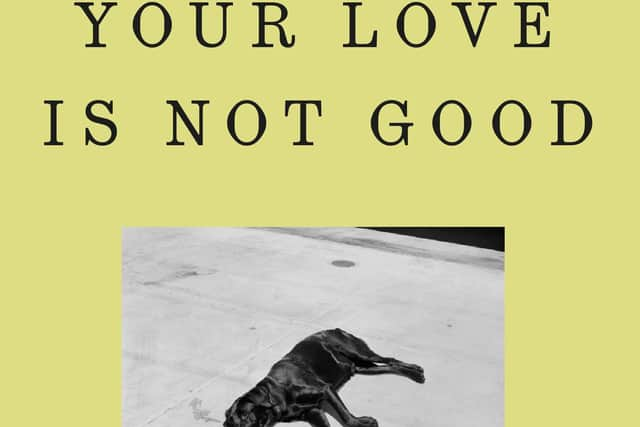Book Club: Smart and poignant tale about an artist in search of their identity


Your Love Is Not Good crams explosive into the cracks between identity and aspiration, between desire and art, and revels in the raining debris. Hedva’s prose invites the reader to a spiralling trip into the art world and its fetishization of identity.
Led by a queer Korean American painter, Your Love Is Not Good takes you through a story about lust, love and obsession. Starting in Los Angeles and continuing in Berlin, Hedva’s main character has to face traumas from her past and confusion in her present as an artist in a novel that is smart, funny and engaging.
Advertisement
Hide AdAdvertisement
Hide AdJohanna Hedva is a queer, disabled Korean-American writer, artist and musician who also wrote the essay "Sick Woman Theory", which has now been translated into six languages.


The Sheffield Telegraph publishes here an exclusive extract of Your Love Is Not Good.
FACTURE
the quality of the execution of a painting; an artist’s characteristic handling of the paint.
During my second year in art school, I signed up for a studio visit with that semester’s guest professor, Joan Raíz, who was the chief curator at the biggest contemporary art museum in California. She was famous and potent and canonical and rare, a Latina curator with power. She’d started during the late 1970s, working in a little gallery that represented only women artists, then ascended through different institutions whose scale and prestige increased proportionally. Her thing was to turn each institution she helmed into a place where artists who usually weren’t supported got support, women and artists of color and especially women artists of color, but also artists who didn’t make objects, whose work couldn’t be categorized by a traditional genre, and queer artists who were flamboyantly perverted and used a lot of nudity. She’d give them huge shows and budgets, and nearly everyone she worked with got famous, either because of Joan and the institutional cachet she lent them or a causality dilemma: Were they interesting before they’d had enough money to fill whole rooms in important museums? By the time she mounted the high throne in the castle, where she’d sat for nearly a decade, she was a legend who could somehow still cash in on her origin in shock. In 1979, she had curated a small show that featured a bucket of menstrual blood at the door. Whether it was real or fake was left to the imagination. Visitors were required to remove their shoes and stand in the bucket before they could enter the gallery. Their bloody footprints dried on the gallery floor and were captured in the single photo of the show that was taken, which became an icon in and of itself. Somehow, everyone knew that all the footprints in this hallowed image belonged to Joan, and the show was considered a failure when it opened. Now that show is taught in every class I’ve ever been in, classes on installation, documentation, sculpture as performance, the artist’s body, feminist art. That bucket of blood has achieved the holy status that only the art world can produce, a type of worshipful reverence people buy into because it’s gratifying to be reassured that all it takes for something to be great is for you to imagine its greatness.
Advertisement
Hide AdAdvertisement
Hide AdWhen I look back at it, adding my name to the paper taped to Joan Raíz’s office door, her list for studio visits, was my first public gesture of ambition. It was a gesture born out of hope that if she came to my studio to sit with me for an hour, power, like a mold, might break off its host and start to grow on me. But it was also a move of survival. Joan was one of the only art-world people I could think of who would genuinely be interested in my work and have the means to take it somewhere.
I hadn’t considered my work to be especially political or even feminist, but then several of my professors and classmates told me that by relentlessly painting my own or other women’s nonwhite faces and bodies, I was doing something revolutionary, taking up space with something that normally isn’t given it. I was insisting that these women be looked at, that they were valuable enough to fill canvases, fill galleries. People were always remarking on what my paintings represented in terms of “the Asian American female experience,” although I had no idea what that experience might be, and I hated the word “female.” I was just painting what I wanted to paint. It takes hours to paint a portrait, and this was who I wanted to spend hours looking at. My queerness didn’t factor into how my work was talked about then as much as it does now because queerness has only emerged in the last few years as being of commercial value to the art world. Before, it had conceptual value, but otherwise, it was masked and abstracted, wall texts in museums using code words like “her lifelong companion,” and stationing signs at the entrances of galleries, warning that the contents were not suitable for children. For its practitioners, queerness lived a fuller life in dark little corners of an underground, the kink party, the dungeon, Monday nights at the bar downtown. There, we were happy to look only at each other, the mainstream had not turned its eye on us yet, and we never expected it to.
[if you need a space filler, then some of the below!]
Independent Bookshop Week – Save the Date!
June 17th-24th is Independent Bookshop Week. is a celebration of independent bookshops in the UK highlighting the vital role independent bookshops play in their communities. Why not visit Sheffield's independent bookshops Rhyme and Reason, Juno Books and La Biblioteka this week and see what their wonderful booksellers recommend for you?
Why shop indie?
Independent bookshops are staffed with book experts who are wildly passionate about reading and getting the right book into the right hands. Independent bookshops bring vitality to our high streets, work with local communities and champion reading for pleasure. Independent bookshops have real passion, real people and real conversations. Independent bookshops offer proper browsing, perfect gifts and they pay their taxes!
How can I celebrate Independent Bookshop Week?
Find your local indie
Shop with them between Saturday 17th - Saturday 24th June 2023.
Share your book purchases on social media, tagging the bookshop, the publisher or author, and @booksaremybag and #IndieBookshopWeek